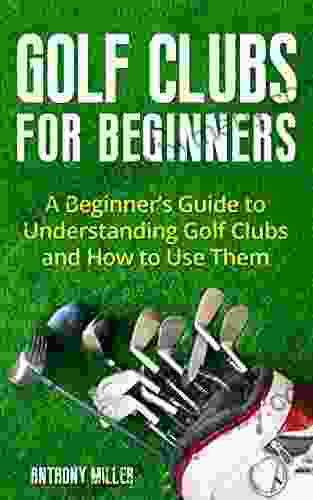Golf Clubs For Beginners: The Ultimate Guide to Unlocking Your Swing to Success

Embark on Your Golfing Journey: Understanding the Essentials
As you embark on your golfing adventure, understanding the intricacies of golf clubs is paramount. Golf clubs are the fundamental tools that will shape your swing, impact your distance, and ultimately determine your success on the course. This article, meticulously crafted for beginners, will delve into the realm of golf clubs, empowering you with the knowledge to select the perfect clubs for your individual needs and elevate your game to new heights.
Navigating the Array of Golf Clubs: Types and Functions
The world of golf clubs encompasses a vast array of options, each designed to serve a specific purpose. Familiarizing yourself with the different types of golf clubs will equip you with a comprehensive understanding of their unique characteristics and how they can contribute to your overall game strategy.
4.1 out of 5
| Language | : | English |
| File size | : | 4288 KB |
| Text-to-Speech | : | Enabled |
| Screen Reader | : | Supported |
| Enhanced typesetting | : | Enabled |
| Word Wise | : | Enabled |
| Print length | : | 35 pages |
| Lending | : | Enabled |
- Woods: Designed for maximum distance, woods are typically used for tee shots and long shots from the fairway. They feature a larger clubhead and longer shaft, enabling you to generate more power and achieve greater distances.
- Irons: Favored for approach shots, irons provide precision and control over distance and direction. They come in various numbers, with lower numbers (e.g., 2-iron) indicating longer distances and higher numbers (e.g., 9-iron) indicating shorter distances.
- Hybrids: Combining the characteristics of woods and irons, hybrids offer versatility and forgiveness. They are perfect for bridging the gap between woods and irons, providing distance and accuracy.
- Wedges: Primarily used for shots around the green, wedges excel at delivering precise, short-range shots. They come in different loft angles, with higher lofted wedges (e.g., sand wedge) designed for getting out of bunkers and lower lofted wedges (e.g., pitching wedge) for approach shots.
- Putters: Specifically designed for rolling the ball on the putting green, putters feature a flat clubhead and a shorter shaft. They are crucial for making accurate, controlled shots towards the hole.
Finding the Perfect Fit: Club Selection for Optimal Performance
Choosing the right golf clubs is not a one-size-fits-all approach. To optimize your performance, it's essential to consider your personal attributes and swing style.
Factors to Consider:
- Height and Arm Length: Taller individuals generally require longer clubs, while shorter individuals may benefit from shorter clubs.
- Swing Speed: Players with faster swing speeds can handle stiffer shafts, while players with slower swing speeds may prefer more flexible shafts.
- Handicapping: Higher handicappers may opt for more forgiving clubs that provide greater stability and accuracy.
Professional Fitting:
For a precise and personalized club selection, consider scheduling a professional club fitting. A trained professional will analyze your swing and provide recommendations based on your unique specifications. This service can enhance your accuracy, distance, and overall golfing experience.
The Art of Swinging: Unlocking the Secrets of Club Usage
Mastering the art of swinging a golf club is the key to unlocking your potential on the course. Here are fundamental techniques to guide your swing:
Grip Basics:
- Interlocking Grip: Place your pinky finger of your right hand (for right-handed golfers) inside the index finger of your left hand.
- Overlap Grip: Position your right pinky finger on top of the left index finger, overlapping them slightly.
- Ten-finger Grip: Simply hold the club with all ten fingers, interlocking them naturally.
Swing Mechanics:
- Stance: Adopt a balanced stance with your feet shoulder-width apart and your knees slightly bent.
- Backswing: Take the club back smoothly, keeping your head down and your weight on your back foot.
- Downswing: Shift your weight forward as you swing the club down, making contact with the ball at the bottom of your swing arc.
- Follow-Through: Continue swinging the club through the ball, finishing with your weight on your front foot.
Strategic Club Selection: Mastering the Course
Selecting the appropriate club for each shot is crucial for navigating the course effectively. Consider the following factors when making your choice:
Distance:
Estimate the distance to the target and choose a club that can reach it comfortably. Woods are for long distances, irons for medium distances, and wedges for short distances.
Lie:
The lie of the ball refers to its position on the ground. If the ball is sitting up in the rough, select a club with more loft to get it airborne. If the ball is in a fairway bunker, consider a sand wedge for a controlled escape.
Wind:
Factor in the wind direction and speed. A strong headwind may require a club with more loft to compensate for the wind resistance. A tailwind, on the other hand, may allow you to use a club with less loft.
: The Pathway to Golfing Success
Understanding golf clubs for beginners is the cornerstone of a successful golfing journey. By familiarizing yourself with different club types, finding the perfect fit, mastering the art of swinging, and employing strategic club selection, you can elevate your game and experience the joys of golf to the fullest.
Remember, practice is essential. The more you play, the more comfortable you will become with your clubs and the more consistent your shots will be. Embrace the learning process, enjoy the challenges, and discover the immense satisfaction that comes with perfecting your swing.
4.1 out of 5
| Language | : | English |
| File size | : | 4288 KB |
| Text-to-Speech | : | Enabled |
| Screen Reader | : | Supported |
| Enhanced typesetting | : | Enabled |
| Word Wise | : | Enabled |
| Print length | : | 35 pages |
| Lending | : | Enabled |
Do you want to contribute by writing guest posts on this blog?
Please contact us and send us a resume of previous articles that you have written.
 Book
Book Novel
Novel Page
Page Chapter
Chapter Text
Text Story
Story Genre
Genre Reader
Reader Library
Library Paperback
Paperback E-book
E-book Magazine
Magazine Newspaper
Newspaper Paragraph
Paragraph Sentence
Sentence Bookmark
Bookmark Shelf
Shelf Glossary
Glossary Bibliography
Bibliography Foreword
Foreword Preface
Preface Synopsis
Synopsis Annotation
Annotation Footnote
Footnote Manuscript
Manuscript Scroll
Scroll Codex
Codex Tome
Tome Bestseller
Bestseller Classics
Classics Library card
Library card Narrative
Narrative Biography
Biography Autobiography
Autobiography Memoir
Memoir Reference
Reference Encyclopedia
Encyclopedia Sir Richard Francis Burton
Sir Richard Francis Burton Department Of The Army
Department Of The Army Deedee Panesar
Deedee Panesar Devin Olsen
Devin Olsen Don Harward
Don Harward Dominique Enright
Dominique Enright Don Graves
Don Graves Devin Carroll
Devin Carroll Grant Cardone
Grant Cardone Delphi Classics
Delphi Classics Don Teague
Don Teague Oliver Kent
Oliver Kent Denise Essex
Denise Essex Randall R Cottrell
Randall R Cottrell Dennis Abrams
Dennis Abrams Deitra Leonard Lowdermilk
Deitra Leonard Lowdermilk Dennis Snow
Dennis Snow Jennifer J Britton
Jennifer J Britton Robert Harris
Robert Harris Nancy Bos
Nancy Bos
Light bulbAdvertise smarter! Our strategic ad space ensures maximum exposure. Reserve your spot today!
 Esteban CoxFollow ·19.7k
Esteban CoxFollow ·19.7k Pablo NerudaFollow ·4.6k
Pablo NerudaFollow ·4.6k Juan ButlerFollow ·13.3k
Juan ButlerFollow ·13.3k T.S. EliotFollow ·6.9k
T.S. EliotFollow ·6.9k Jean BlairFollow ·9.2k
Jean BlairFollow ·9.2k Chase MorrisFollow ·17.9k
Chase MorrisFollow ·17.9k Reed MitchellFollow ·8.8k
Reed MitchellFollow ·8.8k Anthony BurgessFollow ·14k
Anthony BurgessFollow ·14k

 Cruz Simmons
Cruz SimmonsGuide To Pencak Silat Kuntao And Traditional Weapons:...
Immerse yourself in the captivating world of...

 Dalton Foster
Dalton FosterUnlock Your Financial Freedom: Dive into the ABCs of Real...
Are you ready to embark on a...

 George Orwell
George OrwellThe Advanced Guide to Real Estate Investing: Your...
Are you ready to embark on...

 Will Ward
Will WardMargaret Laurence: The Making of a Writer
Margaret Laurence (1926-1987) was one of...

 Jorge Amado
Jorge AmadoThe ABCs of Property Management: A Comprehensive Guide...
Owning and managing rental...
4.1 out of 5
| Language | : | English |
| File size | : | 4288 KB |
| Text-to-Speech | : | Enabled |
| Screen Reader | : | Supported |
| Enhanced typesetting | : | Enabled |
| Word Wise | : | Enabled |
| Print length | : | 35 pages |
| Lending | : | Enabled |














